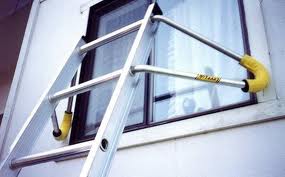What Windows Are Included In My Service?
 We find there is often confusion regarding which windows are included in a window cleaning service. This can lead to frustration by tenants who do not know that some of their windows were not included in the scope.
We find there is often confusion regarding which windows are included in a window cleaning service. This can lead to frustration by tenants who do not know that some of their windows were not included in the scope.
To start, let’s clarify windows are considered commonly considered accessible and which are considered inaccessible.
Accessible Windows
Accessible windows are windows that the tenant or homeowner can safely reach without the use of any specialized equipment or ladders.
Inaccessible Windows
Inaccessible windows are windows that require the use of a ladder, pole, or rope access in order to reach – in whole or in part.
What do I mean by in whole or in part? Windows that are ‘half on and half off’ a balcony, so that half of the windows is situated past the balcony railing and a tenant would have to reach unsafely way over and down to attempt to clean half of it are considered inaccessible. This is because they cannot safely clean the entire window themselves.
Scope of Work
The scope of work submitted on a quote, once agreed to, defines which windows will then be cleaned. It may be inaccessible windows only, all windows including accessible, or a mix of both. Whatever will be done can be found in the description of the scope. For example:
“One hand cleaning by squeegee of all non-balcony, non-patio inaccessible tenant windows including the ground floor windows. Includes exterior surface of railing glass where present, top surface of skylights and glass canopies.”
What does this mean exactly?
It means that all tenant windows will be cleaned with the exception of those on balconies and patios that tenants can clean themselves. Ground floor windows that are NOT on a patio will be included. The glass skylights, canopies around the strata will be cleaned on the top surface only – this is where dust and dirt accumulates. The undersides of canopies and skylights need to be cleaned only rarely. The outside surface of balcony railing glass will be included as well.
When asked “we want all of our windows cleaned, every single one, can you do this?” the answer is course we can. It is a larger scope of work which will take more time and therefore be a higher cost. If the strata wants to spend money having windows cleaned that the owners can easily clean themselves, which is a decision for strata to make, not us. We can do it. But it will be much more expensive. Here is why.
Consider this; on a high rise tower, an owner can step out onto their balcony and clean any windows on that balcony and their sliding glass patio doors in about 5-10 minutes. For us to reach that same area without accessing their suite, a rope access worker has to set up his ropes near the balcony, access the balcony area, disconnect his harness attachments in order to walk around on the balcony and clean the windows, re-attach himself to the ropes, and exit the balcony area. He has to do this carefully so as not to disturb any personal belongings, cannot leave footprints or anything on the balcony which will lead to a complaint, etc. So for each accessible window we clean, the price has to go up. To clean accessible windows on a balcony we can reach by ladder, WCB regulations state that the ladder must be safely tied off before accessing that area. That is a slow process, also impacting the total cost.
So why then do we clean the accessible ground floor windows that are not on a patio?
Well, those windows usually have windows above them. Unless it is a one story building, the architecture is usually such that the windows are in a row vertically. If we clean the windows in that row above the first floor, the chances that we are going to drip dirty water onto that window are high. So, rather than leave it and get complaints that we have dripped on that window and should come back to clean it up, we clean them while we’re there anyway. It increases the odds of customer satisfaction with the work overall.
Happy customers are paramount in any service industry, and the best way to ensure people are satisfied at the end of the service is to ensure clear communication in order to set expectations occurs.
Knowing what is included and what is not by those receiving the service is a key component to ensure things go smoothly and everyone is happy with the results.
























